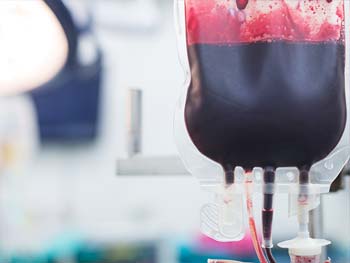
It’s not unusual to be driving down the highway when you suddenly hear emergency sirens and glimpse flashing lights as an ambulance streaks past, carrying an accident victim to the nearest trauma center. You might wonder about the circumstances, maybe even offer up a little prayer for the person inside. What you should be praying for is that enough people have recently donated blood to help save the life of the person injured in a car wreck, or the pedestrian hit by a motorist, or the worker burned in an industrial accident.
Every two seconds, someone in the United States needs blood. The American Red Cross says more than 41,000 blood donations are needed every day. When the ambulance or rescue helicopter arrives at the trauma center, or as the victim’s weeks of surgeries and treatments pass, will there be enough blood products, and the right type, to help him or her survive the injury?
Now is the Time
January is National Blood Donor Month, a time during which blood centers encourage citizens to become donors and honor those who have previously served the public good in this manner. There are already 9.2 million blood donors in the U.S., so you may wonder why they are seeking more. Blood products are used by cancer patients, those undergoing surgery, people with Sickle Cell disease, and many others.
Narrowing our focus to Maryland accident victims, these numbers reflect the potential need for blood donations by the occupant of that ambulance that just passed you on the road:
- From June 2013 through May 2014, there were 18,971 people transported to Maryland trauma centers
- Of those admitted with blunt or penetrating injuries, 26.6% were hurt in a motor vehicle accident; 5.4% were hurt in a motorcycle crash; 4.9% were injured pedestrians.
- Another 712 accident victims received treatment at a burn center.
- Specialized pediatric trauma centers handled 1,613 injuries, 16.4% of which were suffered in a motor vehicle crash, and 638 pediatric burns.
(Source: The Maryland Institute for Emergency Medical Services Systems (MIEMSS) annual report)
According to the American Red Cross, a single car accident victim can require as many as 100 pints of blood. Severe burn victims require approximately 20 units of plasma, the liquid portion of blood in which red and white blood cells and platelets are suspended.
Brian’s Story
One Maryland accident victim who is grateful for blood donors is Brian Boyle, champion athlete now known as “Iron Heart” and National Volunteer Spokesperson for the American Red Cross. The 4th of July weekend last year was the tenth anniversary of the accident which nearly ended his competitive pursuits, not to mention his life. Brian had just graduated from McDonough High School in Pomfret, Maryland, and was heading home after swim practice, driving his Chevy Camaro on a two-lane, winding road. He stopped at a four-way stop sign, then proceeded forward. A dump truck, estimated to be going 30 mph over the speed limit and driven by a man who had several speeding tickets on his record, plowed into the left side of Brian’s car. The impact knocked Brian’s heart across his chest; broke his ribs, collarbone and pelvis; crushed his lungs; damaged every major organ; and burned his skin. Using the Jaws of Life, EMT technicians worked under pressure to extract Brian from the car before he died from blood loss – he actually lost 60% of his blood. He was taken by medical helicopter to Prince George’s Hospital.
Over nearly five months, Brian endured 14 serious operations, 36 blood transfusions, 13 plasma treatments and suffered cardiac arrest 8 times. He was finally released from the hospital for orthopedic rehabilitation at what is now Baltimore’s UM Rehabilitation and Orthopaedic Institute.
Miraculously, Brian defied the predictions that he would never swim again, and might not even walk. Just three years after leaving the Intensive Care Unit, he crossed the finish line at the 2007 Hawaii Ironman competition. Many other marathons followed in the coming years. He graduated cum laude from St. Mary’s College of Maryland in 2010, has written a book, and appeared on the Ellen DeGeneres Show, NBC’s The Today Show, ESPN, Maryland Public Television’s Outdoors Maryland and several other regional news segments with Comcast, NBC, Fox and CBS.
Brian’s story is one of courage and determination, but as he acknowledges, it’s also one that illustrates the way in which a volunteer’s 15-minute blood donation can give years of life to a recipient.
Be a Hero
Sometime during January, learn about being a blood donor. You can find the dates and locations of blood drives near Baltimore on the Red Cross website. If you or your loved ones are ever injured in a motor vehicle accident, explosion, plane crash, or fire, you may find yourself honoring National Blood Donor Month from the other side of the equation.
